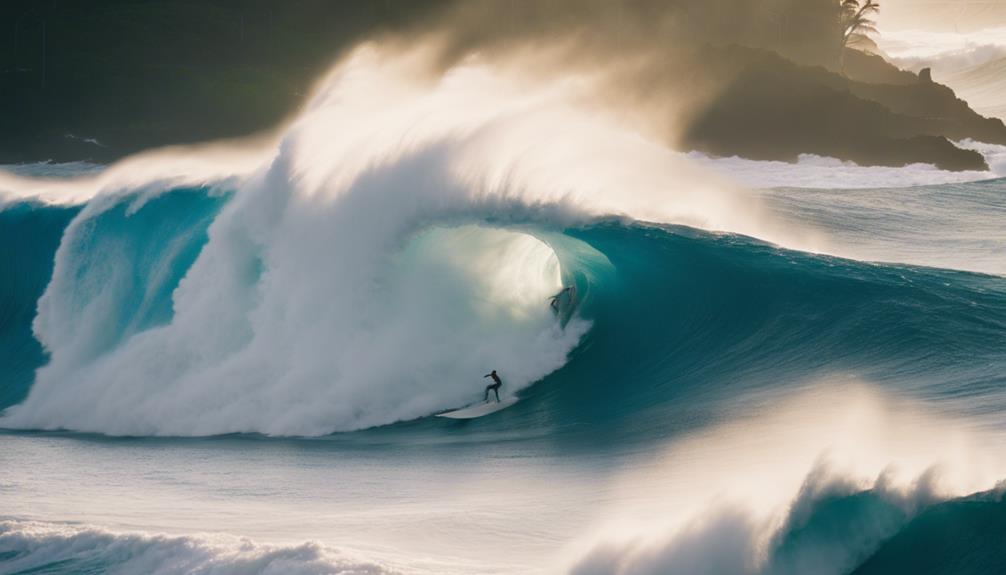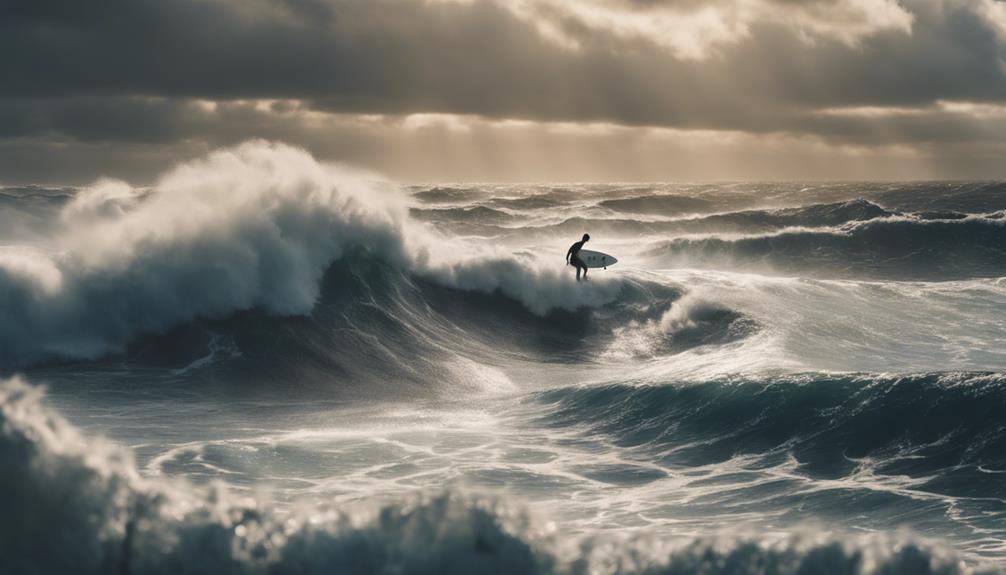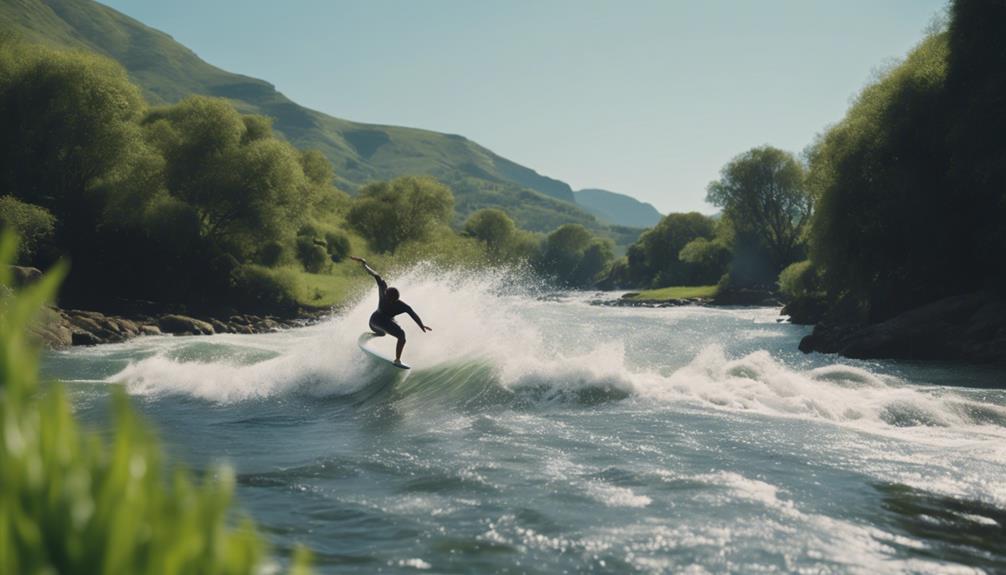Surfing waves can reach staggering heights, especially at spots like Nazaré, Portugal, where winter swells average around 50 feet but can soar to 80 feet on exceptional days. Other locations, such as Mavericks in California and Peahi (Jaws) in Maui, feature waves that often exceed 60 feet, showcasing the power of environmental factors like underwater topography and wind. Records exist of surfers riding waves as tall as 86 feet, which adds to the thrill and challenge of big wave surfing. Curious about other towering wave spots and records? There's plenty more to explore beyond these heights.
Key Takeaways
- Nazaré Canyon can produce winter waves averaging 15 meters (50 feet), with exceptional days reaching up to 24 meters (80 feet).
- Deep water waves can exceed heights of 60 feet, influenced by wind velocity, fetch, and duration.
- Interference patterns from converging waves can create unpredictable surf conditions, potentially amplifying wave height.
- Notable surfing locations like Peahi, Mavericks, and Teahupoo feature waves that can reach heights of 60 feet or more.
Wave Characteristics
When you're out surfing, understanding wave characteristics is essential, as factors like underwater topography and wind conditions greatly influence their height and behavior.
In places like Nazaré, Portugal, the underwater Nazaré Canyon plays an important role in creating big waves. This canyon, stretching 210 km, helps amplify wave height, often producing winter waves averaging 15 meters (50 feet) and exceptional days reaching up to 24 meters (80 feet).
For experienced surfers, recognizing how deep water waves are influenced by wind velocity, fetch, and duration can mean the difference between a thrilling ride and a challenging surf session. These waves travel faster and can exceed heights of 60 feet, making Nazaré a big wave surfing haven.
When waves from different directions converge, interference patterns create unpredictable surf conditions, complicating the dynamics of wave breaks.
The surfing community thrives on this knowledge, as understanding wave characteristics not only enhances safety but also maximizes the enjoyment of riding those towering waves.
Environmental Influences

Environmental factors like storms and ocean currents play an essential role in shaping the height and power of surfing waves. For instance, large waves at locations like Nazaré, Portugal, are influenced by remnants of storms and low-pressure systems, greatly enhancing wave size. The underwater Nazaré Canyon funnels Atlantic swells, creating impressive surfable waves as they approach the shore.
As waves travel from deep to shallow water, they change speed and bend, altering their wave characteristics. This process can lead to larger, more powerful breaking waves. Additionally, interference patterns arise when waves from different directions converge, adding complexity to the surf. These patterns can amplify wave height and make for thrilling rides.
You might also notice green plumes near the shore, which indicate sediment resuspension caused by breaking waves. This interaction between wave dynamics and coastal environments not only affects wave size but also impacts the ecosystem. Understanding these environmental influences helps you appreciate the intricate balance of nature that creates the perfect conditions for surfing.
Notable Surfing Locations

Some of the world's most iconic surfing locations, like Nazaré and Peahi, draw surfers enthusiastic to tackle their massive waves. If you're serious about big wave surfing, you need to check out these legendary surf spots:
- Nazaré, Portugal: Home to record-breaking waves, it's where Sebastian Steudtner rode an astonishing 86 feet wave.
- Peahi (Jaws), Maui: Known for high-performance waves that create thrilling tube rides, attracting professional surfers seeking challenges.
- Mavericks, California: Famous for its extreme danger and waves up to 60 feet, it's a spot where caution is key.
- Teahupoo, Tahiti: Renowned for powerful barrels that break on shallow reefs, it's known for some of the most challenging waves.
Each of these locations offers unique challenges and experiences for surfers like Garrett McNamara, who thrive on tackling the biggest waves in the world.
Whether you're an aspiring professional or a spectator, these surf spots are sure to leave you in awe.
Historical Records

Surfing history is marked by incredible achievements and record-breaking waves, especially at renowned spots like Nazaré, where many of the most significant milestones in big wave surfing have occurred.
The biggest wave ever surfed was ridden by Sebastian Steudtner at Nazaré, measuring a staggering 86 feet (26.2 meters) on October 29, 2020. This remarkable feat followed Garrett McNamara's 78-foot (23.8 meters) record set in November 2011, which helped popularize Nazaré as a premier big wave destination.
Rodrigo Koxa also made waves in the surfing world, achieving an impressive 80-foot (24.4 meters) ride on November 8, 2017, at the same location.
Significantly, Maya Gabeira shattered barriers as the first woman to conquer a wave over 70 feet, successfully riding a 73-foot (22.3 meters) wave at Nazaré on February 11, 2020.
While Nazaré continues to be a hotspot for surfing records, the historical record for the highest wave ever recorded belongs to Lituya Bay, Alaska, which reached an astonishing height of 1,720 feet (524 meters) due to a landslide, illustrating the power of natural forces in shaping our understanding of waves in the world.
Surfing Risks and Challenges

Riding big waves comes with inherent risks and challenges that can test even the most skilled surfers. Whether you're tackling the powerful waves at Mavericks or Nazaré, the extreme environment can be unforgiving.
- Unpredictable conditions: Waves can change dramatically in an instant, making it vital to stay alert.
- Shallow reefs: Locations like Teahupoo present hidden dangers, where breaking waves can lead to serious injuries.
- Potential injuries: From broken boards to fractures, the risks are high for big wave surfers.
- Extreme environment: Harsh weather and ocean conditions can complicate even the simplest rides.
While the thrill of conquering a giant wave is exhilarating, it's important to respect the ocean's power. Surfers at locations like Mullaghmore Head face unique challenges, especially during winter months.
Understanding these surfing risks guarantees you're better prepared to enjoy your time in the water safely. Always assess your abilities and stay informed about the conditions before paddling out into these intimidating waves.
Frequently Asked Questions
How Tall Are Surfing Waves?
Surfing waves can vary widely in height. You'll find ideal beginner waves at 1-2 feet, while massive ones can reach over 30 feet. Some locations even boast record-breaking waves exceeding 80 feet, challenging even the most skilled surfers.
Are 4 Ft Waves Big?
Imagine a friendly giant beckoning you to play; 4-foot waves aren't big for experienced surfers, but they're perfect for you to learn and enjoy. They offer excitement without overwhelming you—ideal for your surfing journey!
How Tall Are the Waves at Nazare?
When you're at Nazaré, you'll see average winter waves around 15 meters, but on exceptional days, they can reach up to 24 meters. The record wave surfed there was an astonishing 26.2 meters!
How Do Waves Get 100 Feet Tall?
Waves can become colossal giants, towering over the ocean. They reach 100 feet tall through the powerful embrace of strong winds, deep underwater canyons, and seasonal storms that release their fury across vast distances.
Are Towering Waves and Sky-High Swells the Same Thing?
Towering waves and sky-high swells may sound similar, but there’s a difference. Towering waves are exceptionally tall waves that rise above surrounding waves, while sky-high swells refer to large, powerful waves. Understanding the distinction can help surfers prepare for varying surfing wave heights explained conditions.
Conclusion
To sum up, towering waves can reach incredible heights, with some of the biggest ever recorded surging over 100 feet tall!
This awe-inspiring phenomenon is shaped by various environmental influences and showcases the thrilling challenges surfers face.
Whether you're riding the waves at renowned locations or just admiring nature's power, the world of surfing offers a unique adventure that's both exhilarating and dangerous.
So, next time you're at the beach, keep an eye out for those massive waves!










